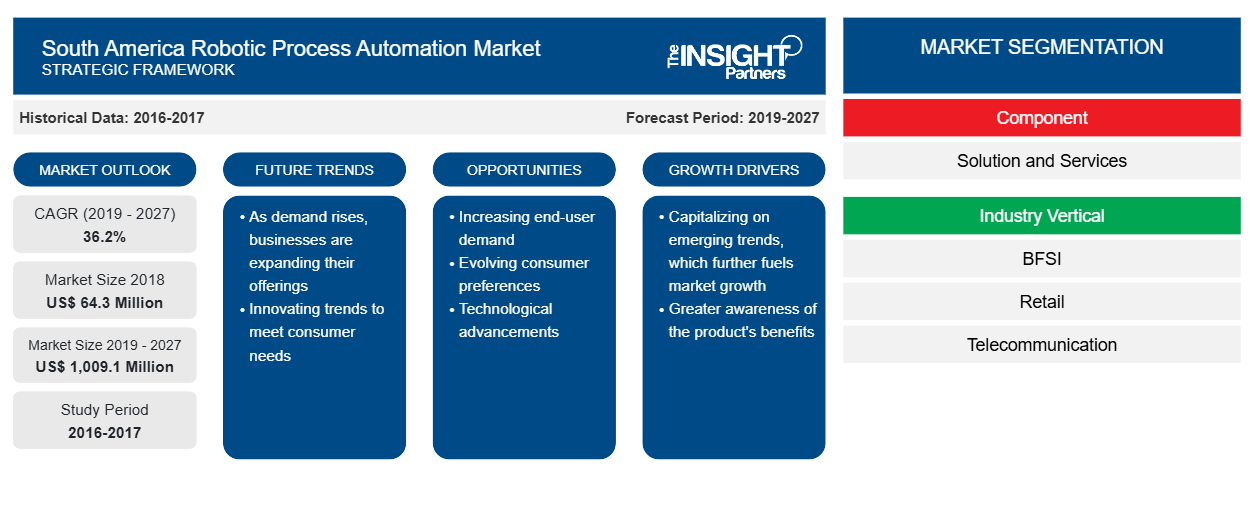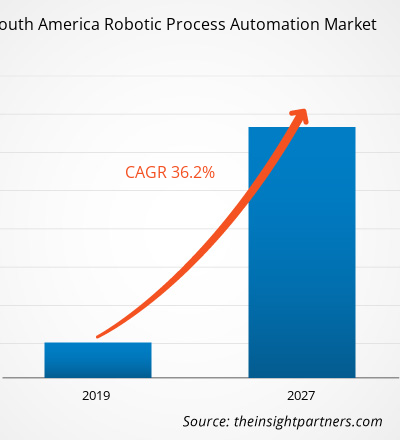The South America Robotic Process Automation market accounted to US$ 64.3 Mn in 2018 and is expected to grow at a CAGR of 36.2% during the forecast period 2019 - 2027, to account to US$ 1,009.1 Mn by 2027.
Due to the increase in the demand for network the telecom industry is facing many challenges in providing the advanced services to its customers. The issues faced by various companies are handling a huge capacity of data, developing new and advanced services, and focusing on business efficiency. Thus, by the adoption of RPA by telecom industry will allow the companies to handle the issues and reorganize its business processes. RPA will permit the companies to easily manage its back office responsibilities as well as handle large volumes of monotonous and rules-based operational processes. The above factors drive the South America Robotic Process Automation market. Furthermore, the key stake holders of South America Robotic Process Automation market include BPM service provider, RPA technology provider, technology integrator, service providers, and end-users or customers. The BPM service providers includes companies such as Infosys, TCS, IBM, Xerox, and others. The RPA technology providers includes IPSoft, BluePrism, OpenSpan, and others.
Lucrative Region Robotic Process Automation Market- This FREE sample will include data analysis, ranging from market trends to estimates and forecasts.
South America Robotic Process Automation Market Insights
Opportunities within the BPO & shared services
Robotics and automation are disruptively transforming the way businesses function. Presently, more than half of the BPO (Business Process Outsourcing) service providers across the globe are engaged into mere replication of client processes, at reduced costs. However, the rapidly advancing technological environment is imposing constant pressure on the BPOs, as their conventional methods pertain to obsolete over the coming years. In addition, the end-clients are also considering automation of processes, while selecting BPO service provider. Owing to these factors the BPO service providers are witnessed investing into robotic automation of various repetitive processes.
In past few years, the BPO service providers, who have already implemented RPA solutions, have attained significant improvisations in their productivity levels and experienced noteworthy gain in their financial stats. This has further encouraged several other BPO service providers to implement RPA at an early stage in order to identify future growth opportunities, reduce debts and evade unwanted costs. In the year 2014, UiPath and Capgemini began to work on an advanced RPA technology, which after a year had reaped into cost reductions exceeded by 60 to 70%. This trend had received positive response from other BPO service providers.
In coming years as RPA innovation advances, more and more BPO, shared services and captive operation initiatives are expected to become targeted for minimal or no human involvement. They would be likely to retool their business models in order to reflect higher service levels such as cost reduction, and enhanced cycle speed. This refurbished business model of the BPOs will have to incorporate RPA products. These factors are expected to drive South America Robotic Process Automation market.
RPA Cost benefits attracting the buyers
RPA provides its users with an ability to in-source and off-shore RPA managed services, which further enables them to regain governance over process without any surplus cost. The cost incurred might even be lesser than off-shore process without RPA. Furthermore, the buyers are also attracted towards the robust return on investments offered through RPA deployments.
The implementation of RPA has proven to provide its buyers with enhanced predictability of costs, and refine overall management of cost, subsequently allowing them to recognize the opportunity to deploy the staff on higher and strategic value roles. Further, as RPA gradually shift to mainstream, several client organizations are expected to find it more comfortable in transiting from traditional incumbent service providers to modern RPA capabilities.
Another factor that is significantly influencing the buyers to invest in RPA driven deals is the rising pressure on them to sustain profitability, regulatory issues and management of increasing cost of offshoring. These factors are expected to drive South America Robotic Process Automation market.
Increased demand for RPA software solutions
Although RPA is at its peak of hype cycle, the advances that are taking place in the technology along with notable success rate showcased by the early adopters has significantly increased the demand for more disruptive RPA software solutions among the large enterprises. The RPA software and service providers have been constantly directing their efforts towards innovating their existing product offerings. These initiatives taken by the market players aims to overcome the key existing challenges in the South America Robotic Process Automation market. The continuous evolution in the product innovation is thus attracting significant interest from the various end-users.
For instance, recently, UiPath along with Humley introduced a chat and speech driven control for enterprise RPA. Apart from this other leading market players like Automation Anywhere and Blue Prism are also making noteworthy investment for stimulating innovation in their offerings. In future years, the South America Robotic Process Automation market is expected to experience several advancements in the technology, subsequently leading to up surged demand for RPA solutions not only in large but also in small and medium enterprises. Thus, these factors are expected to drive South America Robotic Process Automation market.
South America Robotic Process Automation Market - Component Insights
The South America Robotic Process Automation market by component has been segmented into solution and services. In South America Robotic Process Automation market, services segment mainly comprises of training and professional services. The professional services segment further includes various services such as consulting, support and maintenance, and system integration. In South America Robotic Process Automation market, the solution segment holds more share in the year 2019 due to recurring license cost of RPA software. The solution facilitates improvised data security, business efficiency and effectiveness by impersonating human activities and automating routine processes across varied business functions without hampering the on-going system and infrastructure.
South America Robotic Process Automation Market - Component Insights.PNG
- This FREE sample will include data analysis, ranging from market trends to estimates and forecasts.
South America Robotic Process Automation Market - Industry Vertical Insights
The South America Robotic Process Automation market by industry vertical segment is segmented as BFSI, retail, telecommunication, manufacturing, transportation & logistics and others. RPA provides better scalability, reliability, intelligence, speed, enterprise-class, and simplicity to the enterprise leaders. It allows all the employees in a company to interpret and capture the already existing applications for handling various process such as transaction, triggering the response, manipulation of data, and communicating with various other digital systems. RPA are being used where huge number of labor are employed for performing high-volume, highly transactional process functions, for boosting the proficiencies in efficient time by using software. In South America Robotic Process Automation market, BFSI segment accounts for largest market share as RPA automates and expects opportunities for KYC processes with efficient customer’s service, continuous collection and monitoring of data, and account closure processing.
South America Robotic Process Automation Market - Country Insights
The South America Robotic Process Automation market by Country is segmented as Brazil, Colombia, and rest of South America. Robotics has become an exhilarating capability enabling the service providers to suite up their clients with an ability to further digitalize their business processes. The trend is expected to witness significant adoption in South America Robotic Process Automation market for the year to come. In South America Robotic Process Automation market, Brazil accounts for largest market share as various robotics pioneers have expressed their willingness to invest in the technology.
South America Robotic Process Automation Market -
Customize This Report To Suit Your Requirement
You will get customization on any report - free of charge - including parts of this report, or country-level analysis, Excel Data pack, as well as avail great offers and discounts for start-ups & universities
South America Robotic Process Automation Market: Strategic Insights

-
Get Top Key Market Trends of this report.This FREE sample will include data analysis, ranging from market trends to estimates and forecasts.
Merger and acquisition was observed as the most adopted strategy in South America Robotic Process Automation market. Few of the recent mergers and acquisitions are listed below;
2018:
Strategic partnership between Pegasystems Inc. and Idio Ltd (an orchestration platform for Business-to-Business marketing), enabling B2B organizations to present relevant content that hastens customer purchasing journeys. By merging the power of Idio’s content intelligence engine and Pega’s artificial intelligence driven real time customer decision platform, both the companies can close more B2B deals by providing the precise contextual content in the moment across any channel.SOUTH AMERICA ROBOTIC PROCESS AUTOMATION MARKET –SEGMENTATION
Robotic Process Automation by Component
- Solution
- Services
- Training Services
- Professional Services
Robotic Process Automation by Industry Vertical
- BFSI
- Retail
- Telecommunication
- Healthcare
- Transportation & Logistics
- Others
Robotic Process Automation by Country
- Brazil
- Colombia
- Rest of South America
Company Profiles
- Atos SE
- Blue Prism Group PLC
- NICE SYSTEMS
- Pegasystems Inc.
- Thoughtonomy LTD
South America Robotic Process Automation Market Report Scope
| Report Attribute | Details |
|---|---|
| Market size in 2018 | US$ 64.3 Million |
| Market Size by 2027 | US$ 1,009.1 Million |
| CAGR (2019 - 2027) | 36.2% |
| Historical Data | 2016-2017 |
| Forecast period | 2019-2027 |
| Segments Covered |
By Component
|
| Regions and Countries Covered |
South and Central America
|
| Market leaders and key company profiles |
|
South America Robotic Process Automation Market Players Density: Understanding Its Impact on Business Dynamics
The South America Robotic Process Automation Market is growing rapidly, driven by increasing end-user demand due to factors such as evolving consumer preferences, technological advancements, and greater awareness of the product's benefits. As demand rises, businesses are expanding their offerings, innovating to meet consumer needs, and capitalizing on emerging trends, which further fuels market growth.

- Get the South America Robotic Process Automation Market top key players overview
- Historical Analysis (2 Years), Base Year, Forecast (7 Years) with CAGR
- PEST and SWOT Analysis
- Market Size Value / Volume - Regional, Country
- Industry and Competitive Landscape
- Excel Dataset
Recent Reports
Testimonials
Reason to Buy
- Informed Decision-Making
- Understanding Market Dynamics
- Competitive Analysis
- Identifying Emerging Markets
- Customer Insights
- Market Forecasts
- Risk Mitigation
- Boosting Operational Efficiency
- Strategic Planning
- Investment Justification
- Tracking Industry Innovations
- Aligning with Regulatory Trends






















 Get Free Sample For
Get Free Sample For